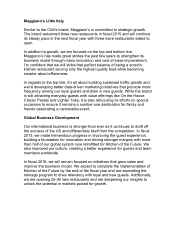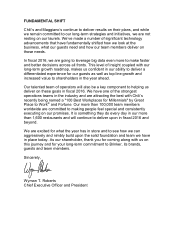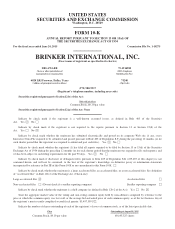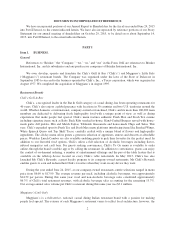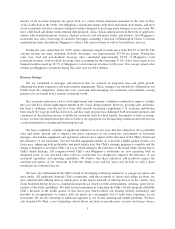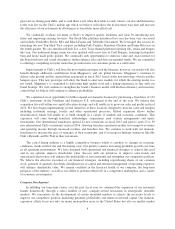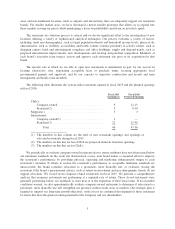Chili's 2015 Annual Report Download - page 15
Download and view the complete annual report
Please find page 15 of the 2015 Chili's annual report below. You can navigate through the pages in the report by either clicking on the pages listed below, or by using the keyword search tool below to find specific information within the annual report.Item 1A. RISK FACTORS.
We wish to caution you that our business and operations are subject to a number of risks and uncertainties.
The factors listed below are important because they could cause actual results to differ materially from our
historical results and from those projected in forward-looking statements contained in this report, in our other
filings with the SEC, in our news releases, written or electronic communications, and verbal statements by our
representatives.
You should be aware that forward-looking statements involve risks and uncertainties. These risks and
uncertainties may cause our or our industry’s actual results, performance or achievements to be materially
different from any future results, performances or achievements contained in or implied by these forward-looking
statements. Forward-looking statements are generally accompanied by words like “believes,” “anticipates,”
“estimates,” “predicts,” “expects,” and other similar expressions that convey uncertainty about future events or
outcomes. We expressly disclaim any obligation to update or revise any forward-looking statements, whether as
a result of new information, future events or otherwise.
Risks Related to Our Business
Competition may adversely affect our operations and financial results.
The restaurant business is highly competitive as to price, service, restaurant location, nutritional and dietary
trends and food quality, and is often affected by changes in consumer tastes, economic conditions, population and
traffic patterns. We compete within each market with locally-owned restaurants as well as national and regional
restaurant chains, some of which operate more restaurants and have greater financial resources and longer
operating histories than ours. The U.S. total employment market is growing, and there is active competition for
quality management personnel and hourly team members. We continue to face competition as a result of several
factors, including quick service and fast casual restaurants also offering high quality food and beverage choices
and the convergence in grocery, deli and restaurant services. We compete primarily on the quality, variety and
value perception of menu items, as well as the quality and efficiency of service, the attractiveness of facilities and
the effectiveness of advertising and marketing programs.
Our restaurants also face competition from the introduction of new products and menu items by competitors,
as well as substantial price discounting among other offers, and are likely to continue to face such future
competition in light of the slow paced economic growth. Although we may implement a number of business
strategies, the success of new products, initiatives and overall strategies is highly difficult to predict and will be
influenced by competitive product offerings, pricing and promotions offered by competitors. Our ability to
differentiate our brands from their competitors, which is in part limited by the advertising spend available to us
and by consumer perception, cannot be assured. These factors could reduce the gross sales or profitability at our
restaurants, which would decrease revenues or profitability generated by company-owned restaurants and royalty
payments from franchisees.
Changing health or dietary preferences may cause consumers to avoid our products in favor of alternative
foods. The foodservice industry as a whole rests on consumer preferences and demographic trends at the local,
regional, national and international levels, including the impact on consumer eating habits of new information
regarding diet, nutrition, health and health insurance. We and our franchisees depend on the sustained demand for
our products, which may be affected by factors outside of our control. Changes in nutritional or health insurance
guidelines issued by federal or local government agencies, issuance of similar guidelines or statistical
information by other federal, state or local municipalities, academic studies, or advocacy organizations, among
other things, may impact consumer choice and cause consumers to select foods other than those that are offered
by our restaurants. We may not be able to adequately adapt our menu offerings to keep pace with developments
in current consumer preferences, which may result in reductions to the revenues generated by our company-
owned restaurants and the payments we receive from franchisees.
9


